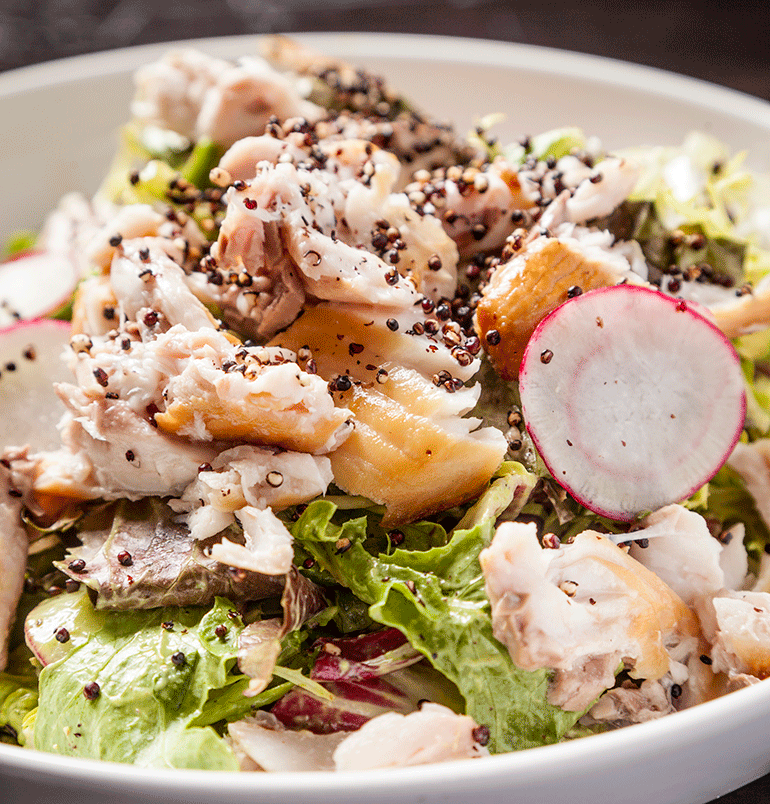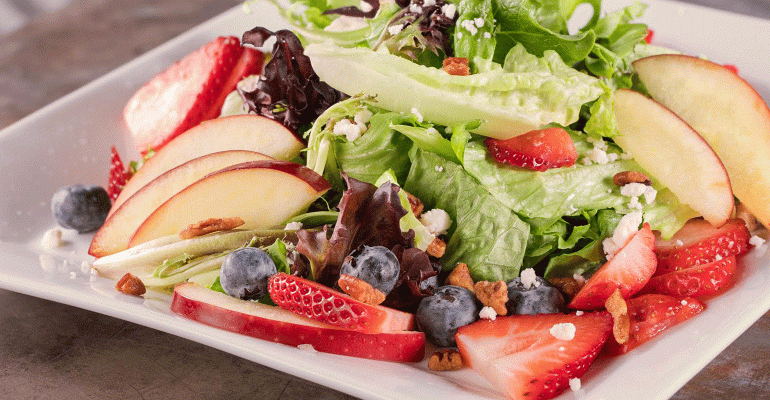Salad is no longer just a side dish or obligatory menu item for dieters, but a main-meal experience.
As consumer interest in salad has grown in recent years, restaurants are revamping or adding new offerings with more intense flavors, contrasting textures and innovative ingredient combinations to create salads that satisfy — and sell.
Seasonal strategies
“The expectation of today’s consumer of a salad is so different,” said Patrick Sugrue, CEO of Saladworks, based in Conshohocken, Pa.
When Sugrue joined the 30-year-old, make-your-own salad chain last year, he felt the chain was still on the leading edge, at least in terms of variety, by offering more than 60 items in some cases.
But he also had a vision for change. That’s when he decided to bring on Andy Revella as executive chef.
“I really felt like we needed a culinary touch on our salads,” Sugrue said. “Someone who could bring in new flavors, toppings consumers were craving. Andy has really brought it.”
Revella explained his take on what today’s consumer wants in a salad.

A promotion for some of the new seasonal items available at Saladworks. Photo: Saladworks
“Seasonality is the most important thing,” he said. “People come to salad because they want to eat better. They want new flavors, but they don’t want them just linear; they want depth of flavor.”
To create depth of flavor in its 14 signature salads and the wide array of items for its custom salads, Saladworks uses more seasonal ingredients and adds more intense and complex flavors.
Among the new or upgraded items introduced this spring are: black beans marinated in jerk seasoning; roasted tri-color carrots; brightly colored and slightly peppery watermelon radish; and Crazy Slaw, a spin on the classic mayo-based coleslaw, made instead with a sweet Asian-style chili sauce.
With same-store sales at the 95-unit chain up 8 percent over last year, and already a little higher than that for 2017, the strategy is working, Sugrue said.
“We’re adding new and exciting toppings, tastes, textures and colors, and that’s adding frequency,” he said.

Cafe Americano's Latino Vegan Quinoa salad. Photo: Cafe Americano
Fresh and seasonal ingredients are also a focus in salads created by chef Matt Fresinki at Cafe Americano, located in the lobby of Caesars Palace in Las Vegas.
Fresinki, who takes frequent trips to his produce provider, said he selects only seasonal and fresh ingredients for all of his salads.
Among the current offerings are the Latino Vegan Quinoa, a hearty salad of mixed greens with a spicy mojo vinaigrette (a blend of oranges, limes, chipotles and smoked paprika) tossed with dried mango for sweetness and fresh roasted corn and crunchy vegetables; and the Chopped Salad, the café’s most popular, made with watermelon radish, pumpkin seeds, slow roasted turkey breast, aged white cheddar and a vinaigrette with fresh herbs.
“First and foremost is picking fresh ingredients. It makes a huge difference,” Fresinki said. “The next most important is seasoning: One of the main reasons why everything tastes better at restaurants is… salt and pepper. We make each of our salads to order and season and taste every single one. After that, it’s all up to your imagination.”
At Halifax, in Hoboken, N.J., executive chef Seadon Shouse creates fresh, seasonal salads like the Seven Vegetable, made with radishes, green beans, peas, endive, cucumber, tomato and squash, and the Roasted Beet and Farro Salad, made with roasted beets, farro, blue cheese, currants, celery and kale, in a spring onion vinaigrette.
“My approach to salads is to keep them in season and let the products speak for themselves,” Shouse said. “If the products going into the salad are at the peak of freshness and in season, then it is easy to make a fantastic salad.”
Tapping into texture
To drive salad sales at Quaker Steak & Lube, a 50-unit, casual-dining chain with an automotive theme, corporate chef Lance Matthews showcases fresh, bright flavors and multiple textures.
“We want to have an appealing salad,” Matthews said. “All of those textures together get your mind working while you’re eating.”
Two new salads are coming in April. The Honey-Stung Fried Chicken Salad, a spin-off of the chain’s popular the Honey-Stung Fried Chicken, features spring mix, chopped romaine lettuce tossed in a sweet onion dressing and topped with fried Honey-Stung Chicken tenders, tomatoes, cheddar-Jack cheese, chopped bacon, red onion and a drizzle of natural honey. The Pecan Chicken Salad is spring mix and chopped romaine lettuce tossed in sweet onion dressing, topped with crispy pecan-crusted chicken breast, cucumber, red onion, tomatoes, mandarin oranges, sweet pecans, Bleu cheese crumbles and dried cranberries.
Matthews is also working on a number of new “concept” salads to be rolled out as spring and fall limited-time offers. One example is the Red, White and Bleu salad with spring salad mix, chopped romaine, apples, strawberries, blueberries, crumbled feta cheese, candied pecans, apple cider vinaigrette and a sprinkle of sumac.

Contrasting textures and flavors play out in Chef Mike Sheerin's Smoked Salmon Salad at Rockit Bar and Grill. Photo: Rockit Bar and Grill
Mike Sheerin, chef at Rockit Bar & Grill in Chicago, said that playing with opposing textures and contrasting flavors is key to making a great salad.
This plays out in Sheerin’s new Smoked Salmon Salad, in which he contrasts the delicate texture of mixed baby greens with the crunch of radicchio and puffed quinoa, and the acidity of freshly squeezed lemon with the sweetness of housemade green goddess dressing.
Similarly, at Ronero in Chicago, chef Cory Morris is using contrasting textures in his Ensalada de Palmito, a version of a hearts of palm salad made with Belgian endive, radicchio, pear, and hazelnuts, all tossed in a coconut crema. The contrast of the hearts of palm, endive and radicchio against the sweet pear and coconut crema, along with the crunch of the hazelnuts, is designed to give the salad a unique texture.
Perfect combos
Memphis, Tenn.-based LYFE Kitchen, a healthful fast-casual chain, is working to create salads that have memorable flavor combinations and are fulfilling.
“Salads have become more robust and inventive throughout the restaurant industry, and they are an important part of our philosophy at LYFE Kitchen,” said Emily Paulsen, director of sales. “The art of crafting a delicious, satisfying salad really comes down to two things: the quality of ingredients and how they are put together. The LYFE core salad line was designed to achieve those perfect combinations.”
As an example, a unique mix of quinoa, fresh raw veggies, hummus and fireman's hot sauce have made the Quinoa Crunch Bowl one of the chain’s most popular items. And the Grilled Veggie Salad gets a singular texture from the combination of raw and grilled vegetables, such as baby spinach, romaine lettuce, grilled peppers, eggplant and snap peas, tossed in a chimichurri vinaigrette.

Vitality Bowls' new Spinach salad topped with seared grass-fed sirloin. Photo: Vitality Bowls
Last year, Vitality Bowls, the San Ramon, Calif.-based chain that specializes in acai bowls, added new superfood salad to its menu. The idea was to appeal to health-conscious consumers with something more than traditional lettuce-based salads, offering salads that pack a superfood punch.
The new salads are Spinach, made with fresh spinach, goat cheese, quinoa, strawberries, almonds and housemade balsamic vinaigrette; and Kale, made with kale, cucumbers, goat cheese, quinoa, celery and housemade Dijon vinaigrette. Customers have the option to add roasted turkey breast or seasoned, seared, grass-fed sirloin to either salad.
“As more people are becoming health conscious, they're looking for creative meal options, so it's important for us to provide unique flavor combinations while utilizing ingredients that match our superfoods cafe concept,” said Uriah Blum, vice president of operations. “We're always recipe testing and researching new ingredients and hope to add to our salad offerings in the coming months.”
But even the freshest in-season ingredients, the most interesting textures or the most creative ingredient combinations won’t matter unless they all work in harmony.
“The flavors have to blend well, or you will lose your guests,” said Matthews of Quaker Steak & Lube.

Photo: artJazz/iStock/Thinkstock; Graphic: NRN/Leigh Anne Zinsmeister

